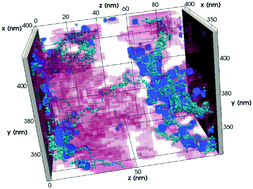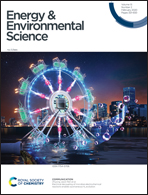Understanding charge transport in donor/acceptor blends from large-scale device simulations based on experimental film morphologies†
Abstract
Bulk-heterojunction organic photovoltaic (OPV) devices consist of active layers made of electron donor/acceptor blends. Understanding the impact of the blend morphologies on the optoelectronic processes occurring in OPVs is of crucial importance for a complete description of the device physics and the achievement of higher device efficiencies. However, high-resolution morphology data are scarce and theoretical methodologies with the appropriate level of details and affordable computational costs are underdeveloped. As a result, previous device modeling often had to rely on artificially generated blend morphologies, which do not represent those in actual devices. Here, by considering three-dimensional donor/acceptor blend morphologies recently determined via electron tomography, we have established an original approach that allows us to perform device-scale simulations of charge transport in actual blend morphologies. The current characteristics, carrier distributions, and internal current pathways and densities are determined and compared to those based on the artificial morphologies often used in OPV-related studies.



 Please wait while we load your content...
Please wait while we load your content...